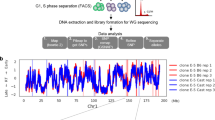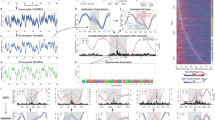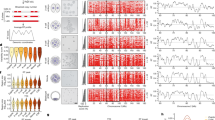Abstract
Many regions of the genome replicate asynchronously and are expressed monoallelically. It is thought that asynchronous replication may be involved in choosing one allele over the other, but little is known about how these patterns are established during development. We show that, unlike somatic cells, which replicate in a clonal manner, embryonic and adult stem cells are programmed to undergo switching, such that daughter cells with an early-replicating paternal allele are derived from mother cells that have a late-replicating paternal allele. Furthermore, using ground-state embryonic stem (ES) cells, we demonstrate that in the initial transition to asynchronous replication, it is always the paternal allele that is chosen to replicate early, suggesting that primary allelic choice is directed by preset gametic DNA markers. Taken together, these studies help define a basic general strategy for establishing allelic discrimination and generating allelic diversity throughout the organism.
This is a preview of subscription content, access via your institution
Access options
Access Nature and 54 other Nature Portfolio journals
Get Nature+, our best-value online-access subscription
$29.99 / 30 days
cancel any time
Subscribe to this journal
Receive 12 print issues and online access
$189.00 per year
only $15.75 per issue
Buy this article
- Purchase on Springer Link
- Instant access to full article PDF
Prices may be subject to local taxes which are calculated during checkout





Similar content being viewed by others
References
Goren, A. & Cedar, H. Replicating by the clock. Nat. Rev. Mol. Cell Biol. 4, 25–32 (2003).
Simon, I. et al. Asynchronous replication of imprinted genes is established in the gametes and maintained during development. Nature 401, 929–932 (1999).
Chess, A., Simon, I., Cedar, H. & Axel, R. Allelic inactivation regulates olfactory receptor gene expression. Cell 78, 823–834 (1994).
Mostoslavsky, R. et al. Asynchronous replication and allelic exclusion in the immune system. Nature 414, 221–225 (2001).
Farago, M. et al. Clonal allelic predetermination of immunoglobulin-κ rearrangement. Nature 490, 561–565 (2012).
Gribnau, J., Luikenhuis, S., Hochedlinger, K., Monkhorst, K. & Jaenisch, R. X chromosome choice occurs independently of asynchronous replication timing. J. Cell Biol. 168, 365–373 (2005).
Alexander, M.K. et al. Differences between homologous alleles of olfactory receptor genes require the Polycomb Group protein Eed. J. Cell Biol. 179, 269–276 (2007).
Miyanari, Y. & Torres-Padilla, M.E. Control of ground-state pluripotency by allelic regulation of Nanog. Nature 483, 470–473 (2012).
Boroviak, T., Loos, R., Bertone, P., Smith, A. & Nichols, J. The ability of inner-cell-mass cells to self-renew as embryonic stem cells is acquired following epiblast specification. Nat. Cell Biol. 16, 516–528 (2014).
Hayashi, K., Ohta, H., Kurimoto, K., Aramaki, S. & Saitou, M. Reconstitution of the mouse germ cell specification pathway in culture by pluripotent stem cells. Cell 146, 519–532 (2011).
Gendrel, A.V. et al. Developmental dynamics and disease potential of random monoallelic gene expression. Dev. Cell 28, 366–380 (2014).
Eckersley-Maslin, M.A. et al. Random monoallelic gene expression increases upon embryonic stem cell differentiation. Dev. Cell 28, 351–365 (2014).
Alves-Pereira, C.F. et al. Independent recruitment of Igh alleles in V(D)J recombination. Nat. Commun. 5, 5623 (2014).
Serwold, T., Hochedlinger, K., Inlay, M.A., Jaenisch, R. & Weissman, I.L. Early TCR expression and aberrant T cell development in mice with endogenous prerearranged T cell receptor genes. J. Immunol. 179, 928–938 (2007).
Brewer, G.J. & Torricelli, J.R. Isolation and culture of adult neurons and neurospheres. Nat. Protoc. 2, 1490–1498 (2007).
Slyper, M. et al. Control of breast cancer growth and initiation by the stem cell-associated transcription factor TCF3. Cancer Res. 72, 5613–5624 (2012).
Hanna, J. et al. Direct reprogramming of terminally differentiated mature B lymphocytes to pluripotency. Cell 133, 250–264 (2008).
Li, F., Chen, J., Solessio, E. & Gilbert, D.M. Spatial distribution and specification of mammalian replication origins during G1 phase. J. Cell Biol. 161, 257–266 (2003).
Dimitrova, D.S. & Gilbert, D.M. The spatial position and replication timing of chromosomal domains are both established in early G1 phase. Mol. Cell 4, 983–993 (1999).
Jackman, J. & O'Connor, P.M. Methods for synchronizing cells at specific stages of the cell cycle. Curr. Protoc. Cell. Biol. 8, 8.3 (2001).
Schlesinger, S., Selig, S., Bergman, Y. & Cedar, H. Allelic inactivation of rDNA loci. Genes Dev. 23, 2437–2447 (2009).
Shufaro, Y. et al. Reprogramming of DNA replication timing. Stem Cells 28, 443–449 (2010).
Ying, Q.L. et al. The ground state of embryonic stem cell self-renewal. Nature 453, 519–523 (2008).
Tsumura, A. et al. Maintenance of self-renewal ability of mouse embryonic stem cells in the absence of DNA methyltransferases Dnmt1, Dnmt3a and Dnmt3b. Genes Cells 11, 805–814 (2006).
Gribnau, J., Hochedlinger, K., Hata, K., Li, E. & Jaenisch, R. Asynchronous replication timing of imprinted loci is independent of DNA methylation, but consistent with differential subnuclear localization. Genes Dev. 17, 759–773 (2003).
Takagi, N. & Sasaki, M. Preferential inactivation of the paternally derived X chromosome in the extraembryonic membranes of the mouse. Nature 256, 640–642 (1975).
Harper, M.I., Fosten, M. & Monk, M. Preferential paternal X inactivation in extraembryonic tissues of early mouse embryos. J. Embryol. Exp. Morphol. 67, 127–135 (1982).
Ensminger, A.W. & Chess, A. Coordinated replication timing of monoallelically expressed genes along human autosomes. Hum. Mol. Genet. 13, 651–658 (2004).
Dutta, D., Ensminger, A.W., Zucker, J.P. & Chess, A. Asynchronous replication and autosome-pair non-equivalence in human embryonic stem cells. PLoS One 4, e4970 (2009).
Wang, J., Valo, Z., Smith, D. & Singer-Sam, J. Monoallelic expression of multiple genes in the CNS. PLoS One 2, e1293 (2007).
Zwemer, L.M. et al. Autosomal monoallelic expression in the mouse. Genome Biol. 13, R10 (2012).
Rodriguez, I. Singular expression of olfactory receptor genes. Cell 155, 274–277 (2013).
Mostoslavsky, R., Alt, F.W. & Rajewsky, K. The lingering enigma of the allelic exclusion mechanism. Cell 118, 539–544 (2004).
Serizawa, S. et al. Negative feedback regulation ensures the one receptor-one olfactory neuron rule in mouse. Science 302, 2088–2094 (2003).
Xu, N., Tsai, C.L. & Lee, J.T. Transient homologous chromosome pairing marks the onset of X inactivation. Science 311, 1149–1152 (2006).
Augui, S. et al. Sensing X chromosome pairs before X inactivation via a novel X-pairing region of the Xic. Science 318, 1632–1636 (2007).
Hewitt, S.L. et al. RAG-1 and ATM coordinate monoallelic recombination and nuclear positioning of immunoglobulin loci. Nat. Immunol. 10, 655–664 (2009).
Brandt, V.L., Hewitt, S.L. & Skok, J.A. It takes two: communication between homologous alleles preserves genomic stability during V(D)J recombination. Nucleus 1, 23–29 (2010).
Masui, O. et al. Live-cell chromosome dynamics and outcome of X chromosome pairing events during ES cell differentiation. Cell 145, 447–458 (2011).
Mostoslavsky, R. et al. κ chain monoallelic demethylation and the establishment of allelic exclusion. Genes Dev. 12, 1801–1811 (1998).
Cedar, H. & Bergman, Y. Choreography of Ig allelic exclusion. Curr. Opin. Immunol. 20, 308–317 (2008).
Cedar, H. & Bergman, Y. Programming of DNA methylation patterns. Annu. Rev. Biochem. 81, 97–117 (2012).
Hudson, Q.J., Kulinski, T.M., Huetter, S.P. & Barlow, D.P. Genomic imprinting mechanisms in embryonic and extraembryonic mouse tissues. Heredity 105, 45–56 (2010).
Sun, D. et al. Epigenomic profiling of young and aged HSCs reveals concerted changes during aging that reinforce self-renewal. Cell Stem Cell 14, 673–688 (2014).
Donley, N., Smith, L. & Thayer, M.J. ASAR15, A cis-acting locus that controls chromosom0e-wide replication timing and stability of human chromosome 15. PLoS Genet. 11, e1004923 (2015).
Donley, N., Stoffregen, E.P., Smith, L., Montagna, C. & Thayer, M.J. Asynchronous replication, mono-allelic expression, and long range Cis-effects of ASAR6. PLoS Genet. 9, e1003423 (2013).
Hochedlinger, K. & Jaenisch, R. Monoclonal mice generated by nuclear transfer from mature B and T donor cells. Nature 415, 1035–1038 (2002).
Markoulaki, S., Meissner, A. & Jaenisch, R. Somatic cell nuclear transfer and derivation of embryonic stem cells in the mouse. Methods 45, 101–114 (2008).
Molofsky, A.V. et al. Bmi-1 dependence distinguishes neural stem cell self-renewal from progenitor proliferation. Nature 425, 962–967 (2003).
Shackleton, M. et al. Generation of a functional mammary gland from a single stem cell. Nature 439, 84–88 (2006).
Stingl, J. et al. Purification and unique properties of mammary epithelial stem cells. Nature 439, 993–997 (2006).
Guo, W. et al. Slug and Sox9 cooperatively determine the mammary stem cell state. Cell 148, 1015–1028 (2012).
Debnath, J., Muthuswamy, S.K. & Brugge, J.S. Morphogenesis and oncogenesis of MCF-10A mammary epithelial acini grown in three-dimensional basement membrane cultures. Methods 30, 256–268 (2003).
Acknowledgements
We thank N. Grover for statistical analyses, J. Hannah (Weizmann Institute, Rehovot, Israel) for providing the BiPS cells and M. Berger for help with FACS sorting. This work was supported by research grants from the Israel Academy of Sciences (grant 419/10 to H.C., grant 734/13 to Y.B.), the Israel Cancer Research Foundation (grant 210910 to H.C., grant 211410 to Y.B.), The Binational Science Foundation (grant 2100289 to Y.B.), The Emanuel Rubin Chair in Medical Sciences (Y.B.), the European Research Council (grant 268614 to H.C.), Rosetrees Foundation (H.C.), the Israel Centers of Excellence Program (41/11 to H.C., grant 1796/12 to Y.B.) and Lew Sanders (H.C.).
Author information
Authors and Affiliations
Contributions
H.M. and M.F. designed and conducted the experiments, interpreted the results and assisted in manuscript preparation. M.H. validated the replication timing data by ReTiSH analysis. R.C. generated the mammospheres, K.M. and Y. Buganim generated ES lines 11 and 12 and assisted in generating the EpiSCs, T.B.-C. generated the neurospheres and assisted in designing methods for the other spheroids. H.C. and Y. Bergman directed the study and wrote the manuscript.
Corresponding author
Ethics declarations
Competing interests
The authors declare no competing financial interests.
Integrated supplementary information
Supplementary Figure 1 Generation of EpiSC and NPCs.
(a) Single-cell clones of EpiSCs were generated from ES (LN3). Briefly, ES (LN3) cells were grown on gelatin coated dishes in N2B27 medium containing LIF and 2i and replated after several days on plates that were incubated with MEF medium overnight. Cells were grown with N2B27 media, 1% KSR and supplemented with 12 ng/ml of βFGF and 20 ng/ml activin for two weeks. Cultures were split every three days over a period of 2 weeks and subjected to limiting dilution to obtain single cell clones that were then picked and fixed for FISH analysis. (b) An example of EpiSC colony morphological view from day 0 (ESCs) until two weeks after induction. (c) To verify the nature of these EpiSCs clones, they were analyzed by real-time PCR analysis, using specific primers, for genes specifically expressed in ES cells (Nanog, Oct4, klf4, klf5 and Rex1) versus genes that are specifically expressed in EpiSCs (Lin28b, Fgf5, Dnmt3b, Sox17, Wnt3, Gata4 and Gata6) (Table S1). (d) Single NPC cell clones were generated from ES (LN3) cells in a step-wise manner. Briefly, ES cells were grown on gelatin coated dishes in N2B27 medium containing LIF and 2i for 7 days and then replated on bacterial Petri-dish plates to induce neurosphere formation using N2B27 medium supplemented with 10 ng/ml EGF and 10 ng/ml βFGF. After 3 days the floating cells from the Petri-dish were plated again on gelatin-coated dishes using the same medium and supplements. Individual colonies of NPCs were picked under the microscope and subcloned using limiting dilution. Single cell colonies were dissociated and fixed for FISH analysis. (e) An NPC colony morphological view from day 0 (ES (LN3)) until NPCs were attached to the coated dishes and picked as single colonies. (f) To verify the nature of these NPC clones, they were subjected to real time PCR analysis. Specific primers were used to detect genes that are specifically expressed in ES cells (Nanog, Oct4, klf4 and Rex1) versus genes that are specifically expressed in NPC cells (Pax6, Olig2, Nestin and Vimentin) (Table S1). (g) The asynchronous replication timing pattern of the Igκ and the olfactory receptor (OlfR) loci on chromosome 6 is presented. ES cells (LN3), mamospheres, neurospheres, NPCs, EpiSCs and pre-B cells clones were labeled with BrdU and assayed for FISH analysis using the mentioned probes. A probe for the synchronously early replicating control gene, A2m (early-E) was also detected. In each case the percentage of single/single (SS), single/double (SD) and double/double (DD) signals in interphase nuclei was counted.
Supplementary Figure 2 Asynchronous Igκ replication.
ES cells were labeled with BrdU for 2 h and then harvested and separated into G1, S1-S5, G2 fractions by fluorescence activated sorting, BrdU DNA then isolated by immunoprecipitation and subjected to semi-quantitative PCR analysis with specific primers for the Igk locus, as an example of an asynchronously replicating gene. The replication time patterns of early (α -globin) (left arrow, S2) and late (Amylase) (right arrow, S5) controls are also shown. The graph represents a quantitative analysis of gel panels shown below.
Supplementary Figure 3 Fixed replication timing at synchronous replicating genes.
Illustration for the late-early (a) and early-early (b) ReTiSH assay (as described in Figs. 3 and 4) of synchronous genes: the light grey line represents the paternal allele of the synchronous genes; Adyc8 (Adenylatecyclase 8, on chromosome 11), a late replicating gene (a), and the early replicating synchronous gene A2m (Alpha-2-macroglobulin, on chromosome 6) (b). The black line represents the maternal allele of these synchronous replicating genes (a, b). Both genes show a fixed replicating pattern, with either early (A2m) or late (Adyc8) replication during every cell division. Single/Single dots (SS) are expected for Adyc8 (late replicating) in the late-early BrdU labeling protocol (green dots), and again Single/Single dots (SS) are expected for A2m (early replicating) in the early-early assay (green dots). (c) Late-early and early-early ReTiSH experiments using ES (LN3) cells. DAPI-stained nuclei were hybridized using the indicated probes. (d) The number of nuclei with two hybridization dots was counted (A2m, n=109; Adyc8, n=114). No Single or Single/Double nuclei were observed and this serves as a control in comparison to the switching seen for asynchronously replicating regions.
Supplementary Figure 4 Fixed replication timing at imprinted loci.
(a) Illustration for the late-early ReTiSH assay of the imprinted genes; H19 and Tfpi2. The black line represents the paternal chromosome and the grey line represents the maternal chromosome. Both genes showed a fixed replication pattern during every cell division. (b, c) Late-early ReTiSH experiments on imprinted genes in ES (LN3) cells. The number of nuclei with two hybridization dots was counted (H19, n=143; Tfpi2, n=108).
Supplementary Figure 5 Role of DNA methylation in replication time choosing.
(a) WT and TKO ES cells were grown in medium containing LIF and then 3 μM CHIR and 1 μM PD (2i) were added. After several passages the cell inhibitors were removed and cells were grown for several more passages. The cells were labeled with BrdU and then prepared and assayed for replication timing using probes for Nanog and Igκ. Replication time was determined by the percentage of cells carrying a single/double (SD) pattern. In each case 100-300 cells were counted. The graphs depict the approximate replication time of each allele (arrows). The red arrow shows the timing of the early allele (percent single/single (SS) nuclei), and the blue arrow shows the timing of the late allele (percent SS+SD nuclei). (b) TKO ES cells were grown as in (a). The degree of asynchrony was determined by the percent of cells carrying a single/double (SD) pattern. In each case 100-300 cells were counted. The percent SD in LIF as opposed to 2i was found to be statistically significant (P=0.01), while there was no difference in cells before and after removal of 2i (P>0.9), as determined by the exact Kruskal-Wallis Test.
(c) WT and TKO ES cells were grown as in (a). All samples were analyzed by real-time PCR analysis using specific primers for pluripotent genes; Nanog, Oct4, Lin28b, Dppa3, Utf1, Tfcp2I1, Sox2 and Rex1, (Marks, H. et al. Cell 149, 590–604, 2012). All normalized to the Ubc, Hprt and Ppia housekeeping control genes. Relative expression levels are shown, values are means and error bars indicate standard deviation.
Supplementary information
Supplementary Text and Figures
Supplementary Figures 1–5 and Supplementary Table 1 (PDF 1174 kb)
Rights and permissions
About this article
Cite this article
Masika, H., Farago, M., Hecht, M. et al. Programming asynchronous replication in stem cells. Nat Struct Mol Biol 24, 1132–1138 (2017). https://doi.org/10.1038/nsmb.3503
Received:
Accepted:
Published:
Issue Date:
DOI: https://doi.org/10.1038/nsmb.3503
This article is cited by
-
Epigenetic control of chromosome-associated lncRNA genes essential for replication and stability
Nature Communications (2022)
-
Chromosomal coordination and differential structure of asynchronous replicating regions
Nature Communications (2021)
-
Control of DNA replication timing in the 3D genome
Nature Reviews Molecular Cell Biology (2019)



